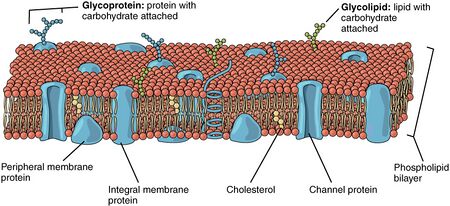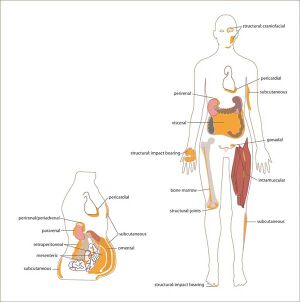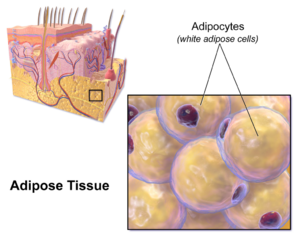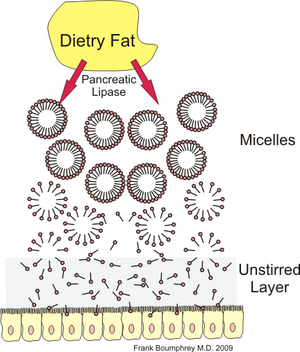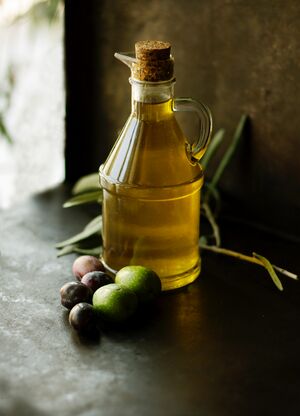Lipids
Original Editor - Lucinda hampton
Top Contributors - Lucinda hampton, Rahma Ahmed Ahmed Bahbah and Kim Jackson
Introduction[edit | edit source]
Lipids are fatty, waxlike molecules found in the human body and other organisms. They serve several different roles in the body, including fuelling it, storing energy for the future, sending signals through the body and being a constituent of cell membranes, which hold cells together[1].
- Their importance in the biological world is immense. They fill a number of important roles in the cells of all of Earth’s organisms.
- Of the four molecules of life, lipids arguably have the greatest variation in their basic structure and are far more difficult to define than proteins, carbohydrate and nucleic acids[2].
- Lipids are essential for all life on Earth. They play many important roles in maintaining the health of an organism.[2].
Image 1: The cell membrane of the cell is a phospholipid bilayer containing many different molecular componants, including proteins and cholesterol, some with carbohydrate groups attached.
Classification[edit | edit source]
Lipids are important fats that serve different roles in the human body. The three main types of lipids are:
- Triglycerides (also knowns as fats) make up more than 95 percent of lipids in the diet. Triglycerides are lipids you obtain from food sources, eg cooking oils, butter, animal fat, avocados, olives, corn, and nuts. Triglycerides provide insulation that keeps you warm while protecting your internal organs with a layer of padding. They also play a role how your body uses vitamins. When you don't burn all the calories you consume, they're converted to triglycerides and stored for future use. Those free fatty acids can then be used by the body to form energy. If you regularly eat more calories than you burn or eat too much food rich in fats, your triglyceride level may become too high and pose a health risk.
- Phospholipids make up only about 2 percent of dietary lipids. Phospholipids are derivatives of triglycerides. They're very similar to them but slightly different on a molecular level. Half of each molecule is water-soluble and the other is not, which causes them to react differently than triglycerides. Located on cell membranes, they form double-layered membranes with the water-soluble molecules on the outside of the cell membrane and the water-insoluble molecules in the inside. These lipids are responsible for protecting and insulating cells.
- 3.Steroids are the least common type of lipid. Cholesterol is perhaps the best well-known steroids. Hormones include the sex hormones estrogen and testosterone, as well as your other hormones like adrenaline, cortisol and progesterone. Cholesterol, the most abundant steroid lipid in the body, is required in every cell in the body. The body gets only a small amount of its cholesterol through food, the body producing most of it. It plays a role in cell repair and the formation of new cells. However, too much cholesterol is a bad thing. When it combines with other compounds in the blood, it can build up as plaque in the arteries. Having a high cholesterol level increases your risk of cardiovascular disease.[3]
Role of Lipids[edit | edit source]
These are listed below
Energy Production and Storage
While both carbohydrates and lipids provide the fuel to energize your body, carbohydrates are the most readily available source of energy, and lipids function primarily as the body’s backup energy reserves. Fat is energy dense, containing 9 calories per gram, whereas protein and carbohydrate contain only 4 calories per gram. About half of the fuel your body needs when at rest or during everyday activity comes from lipids. If you consume more calories than you need in a day, the excess energy is stored as lipids in adipose cells. In between meals and during exercise your body relies on these fats stores to provide energy.
Insulation and Protection
Lipids are also used to insulate and protect your body. You have a layer of fat just below your skin that helps to keep your internal body temperature regular despite the external temperature. Your vital organs eg the kidneys, have a layer of fat around them that acts like bubble wrap to protect them from injury. Without this lipid layer, every bump and bruise could hurt your organs.
Image 5: White adipose distribution in the body.
Cell Wall Structure
The essential lipids, linolenic acid (the primary dietary omega-6 fatty acid) and linoleic acid, are vital to your health; they cannot be made in your body and must come from your diet. They are used in the production of cell membranes and hormones, as well for maintaining vision and supporting the immune system. These lipids provide structure and support for the walls of every cell in your body. Communication between cells is also dependent upon lipids in your cells' membranes.
Hormone Production
Cholesterol is a type of lipid needed to produce important steroid hormones in your body. Estrogen, testosterone, progesterone and the active form of vitamin D are all formed from cholesterol and are needed to maintain pregnancy, develop sex characteristics and regulate calcium levels in your body. According to the American Heart Association, about 25 percent of the cholesterol in your blood comes from your diet, from animal foods such as egg yolks, cheese and shrimp, and the other 75 percent is formed in your liver and cells.
Lipid Storage[edit | edit source]
Lipids (eg cholesterol, cholesteryl esters and triglycerides) are stored in your body primarily in specialized fat cells called adipocytes, which comprise a specialized fatty tissue called adipose tissue. Stored lipids can be derived from the lipids in your diet or from lipids that your body synthesizes. Adipocytes have an almost unlimited capacity to store lipids in cell organelles called lipid droplets, which can grow to a very large size. Although adipose tissue has essential functions in your body, excessive lipid storage can compromise cell function.[1]
Lipid Metabolism[edit | edit source]
Lipids play a crucial role in our body as a highly concentrated source of energy, as their caloric density of 9 kcal per gram, which is more than those of carbohydrates and proteins, and allow our bodies to store up to 100,000 kcal of energy.[4]
Lipids in your body are essential for proper digestion and absorption of food and nutrients. Triglycerides are the most common examples of lipid. The insoluble property of lipids makes the digestion and absorption of fats a complicated process. Since they are hydrophobic, fats stick together as a large glob of insoluble mass after reaching the stomach. It is broken down with the help of bile juice, which contains bile salts. These broken molecules are then acted upon by pancreatic lipase, the major fat-absorbing enzymes in the body. Pancreatic lipase breaks down fats into tiny molecules of free fatty acids and monoglycerides, which are small enough for the small intestine to push through into the bloodstream.[5]
Image: Lipid digestion, the formation of micelles in the presence of bile salts and passage of micelles and fatty acids through the unstirred (aqueous diffusion) layer
Physiotherapy[edit | edit source]
As educators the role of lipids in the diet for Athletes should be explained and referred on to a dietician if appropriate.
The general public’s view of macronutrients has undergone sweeping changes in recent years. Dietary fats are a key example. Since the anti-fat health education initiatives of the 1980s and early 1990s, certain dietary fats have been increasingly recognized as actually beneficial to health. Athletes, like the mainstream populace, are now getting the message that wise dietary fat (triacylglycerol) choices offer essential fatty acids, blood lipid management, maintained endocrine and immune function, inflammation control, metabolic effects and even potential body composition and performance benefits. [6]
- The American Heart Association recommends Americans limit their total fat intake to between 25 and 35 percent of total calories. Overindulging in fat from any source increases your calorie intake, putting you at risk for becoming overweight, which is a risk factor for developing diabetes, heart disease, some cancers and high blood pressure. To reduce fat intake, replace high-fat foods with lower fat ones, such as fruits, vegetables, whole-grain breads and cereals. If you eat a diet of 2,000 calories per day, ingest between 44 grams and 77 grams of total fat daily. Food examples of healthy fats eg One teaspoon of olive oil contains 4.5 grams of fat of which .621 (g) are saturated fat 3.5 grams are monosaturated fat; large egg contains 4.8 grams of fat, and 6.3 grams of protein
Endurance sport athletes
- To maintain good health while training for endurance sports, you need to consume a range of different types of fatty acids which are to be found in saturated fats, mono-unsaturated fats and polyunsaturated fats.
- Fatty acids are essential components of every cell in your body, forming part of the cell membrane. The brain and nervous system cannot function properly without a healthy cell membrane.
- Fat is also needed to absorb and transport the fat soluble vitamins A, D, E and K. The essential Omega-6 fatty acids and Omega-3 fatty acids can only be obtained from food. These types of polyunsaturated fatty acids are necessary to produce hormone like compounds that reduce unnecessary blood clotting, boost immune function and reduce inflammation – all important to an endurance athlete[7]
- Exercise-induced damage to muscles triggers increases in strength and endurance. This damage also leads to inflammation in the muscles. When muscles are inflamed, they are sore, also losing strength and range of motion. Omega-3 fatty acids especially are needed to regulate the level of inflammation in your body. A diet low in omega-3 fats, while high in the more common omega-6 fats, can bias your body towards inflammation, impairing exercise recovery.[8]. You can get high amounts of omega-3 fats from fatty fish, algae, and several high-fat plant foods. eg salmon, oysters, sardines, linseeds.
References[edit | edit source]
- ↑ 1.0 1.1 SF gate What are lipids used for? Available: https://healthyeating.sfgate.com/three-classifications-lipids-found-food-human-body-11865.html(accessed 21.11.2021)
- ↑ 2.0 2.1 basic Biology Lipids Available: https://basicbiology.net/micro/biochemistry/lipids(accessed 21.11.2021)
- ↑ Maricopa Lipids Available: https://open.maricopa.edu/nutritionessentials/chapter/lipids/(accessed 21.11.2021)
- ↑ Natesan V, Kim SJ. Lipid metabolism, disorders and therapeutic drugs–review. Biomolecules & therapeutics. 2021 Nov 11;29(6):596.
- ↑ Byjus Digestion and Absorption Available: https://byjus.com/biology/digestion-and-absorption/(accessed 21.11.2021)
- ↑ Lowery LM. Dietary fat and sports nutrition: a primer. Journal of sports science & medicine. 2004 Sep;3(3):106. Available: https://www.ncbi.nlm.nih.gov/pmc/articles/PMC3905293/ (accessed 21.11.2021)
- ↑ Endurance Sports Nutritionist The Importance of Fat for Endurance Athletes Available: https://www.endurancesportsnutritionist.co.uk/importance-fat-endurance-athletes/(accessed 21.11.2021)
- ↑ SF gate Saturated Vs. Unsaturated Fats in Lipids Available: https://healthyeating.sfgate.com/saturated-fats-primarily-found-groups-1124.html (accessed 21.11.2021)
